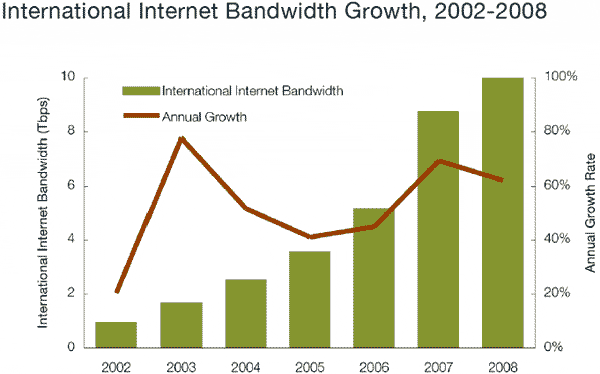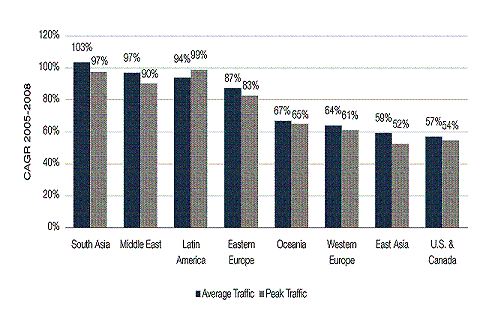Internet traffic increased by 53%, but backbones have become freer
According to TeleGeography statistics , over the past year (from summer 2007 to summer 2008) the volume of international Internet traffic has increased by 53%. However, the average load of backbones decreased from 31% to 29%, that is, they were freed up by almost 7% (100- (31/29 * 100)).

The diagram shows that the capacity of the main communication channels for the year increased by 62% (by 10 Tbit / s), so the statements of telecoms and hysteria in the media about the fact that “Internet channels do not withstand the load” are, to put it mildly, unreasonable.
The backbone capacity has been growing at an accelerated pace for the second year in a row.
')

The average load of backbones decreased from 31% to 29%, and the peak load from 44% to 43%. True, in some directions (from the USA to South America and Canada), the channel congestion is much higher than the average, and on the transatlantic channels it is lower than the average. However, in the coming years, the Internet is definitely not in danger.
Maximum traffic growth occurred in destinations from South America, the Middle East and South Asia.

It should be noted that the cumulative annual increase of 53% is slightly less than it was a year earlier (61%). The fact is that for a long time in the world there has been a decrease in new connections via broadband communication channels. Users are less likely to “rest against” the speed limit, and more likely already against their own limit on content consumption (more precisely, video content). This limit simply cannot grow one and a half times annually, although it is steadily increasing for each user.

The diagram shows that the capacity of the main communication channels for the year increased by 62% (by 10 Tbit / s), so the statements of telecoms and hysteria in the media about the fact that “Internet channels do not withstand the load” are, to put it mildly, unreasonable.
The backbone capacity has been growing at an accelerated pace for the second year in a row.
')

The average load of backbones decreased from 31% to 29%, and the peak load from 44% to 43%. True, in some directions (from the USA to South America and Canada), the channel congestion is much higher than the average, and on the transatlantic channels it is lower than the average. However, in the coming years, the Internet is definitely not in danger.
Maximum traffic growth occurred in destinations from South America, the Middle East and South Asia.

It should be noted that the cumulative annual increase of 53% is slightly less than it was a year earlier (61%). The fact is that for a long time in the world there has been a decrease in new connections via broadband communication channels. Users are less likely to “rest against” the speed limit, and more likely already against their own limit on content consumption (more precisely, video content). This limit simply cannot grow one and a half times annually, although it is steadily increasing for each user.
Source: https://habr.com/ru/post/38956/
All Articles